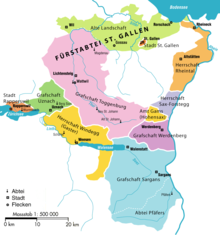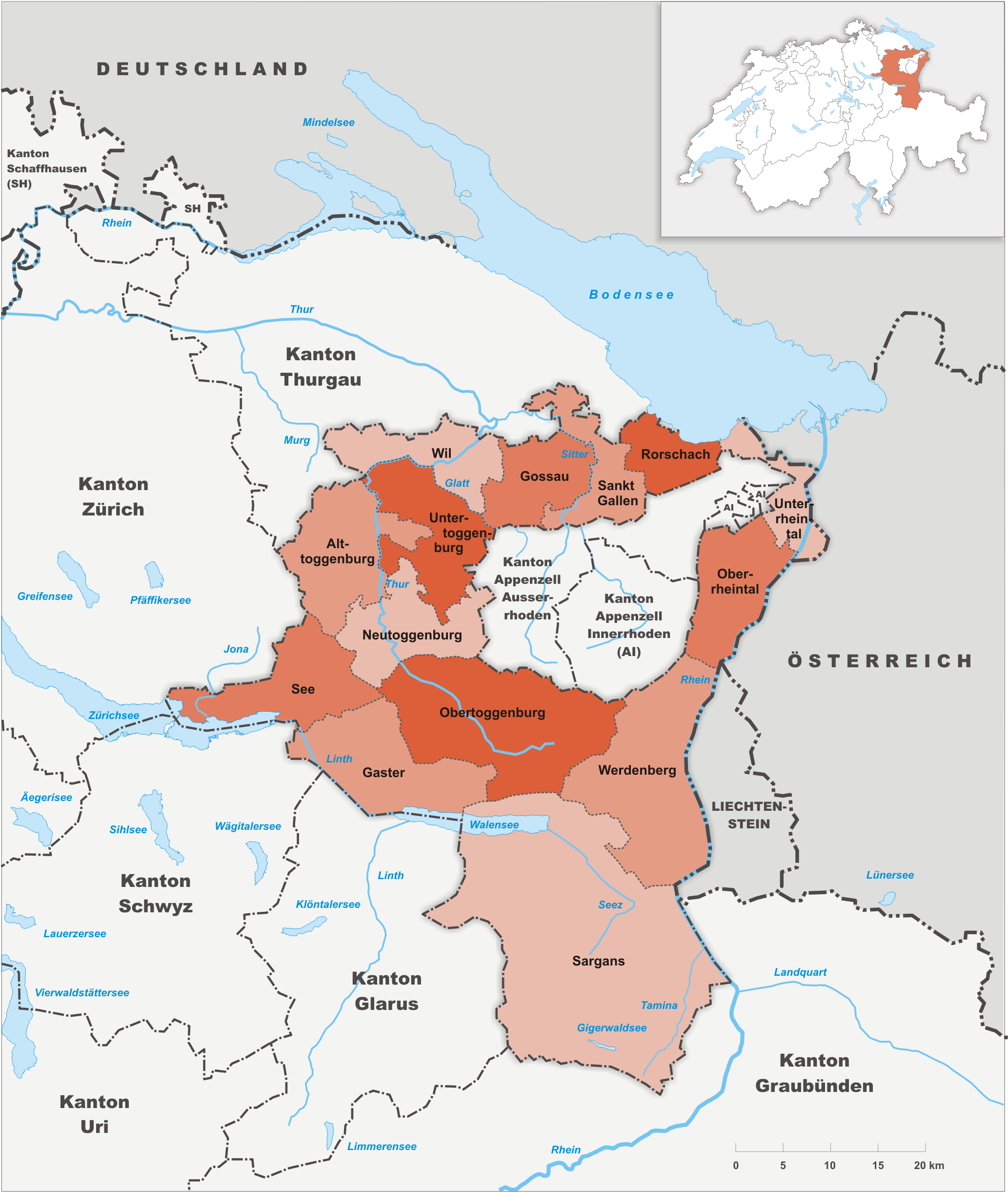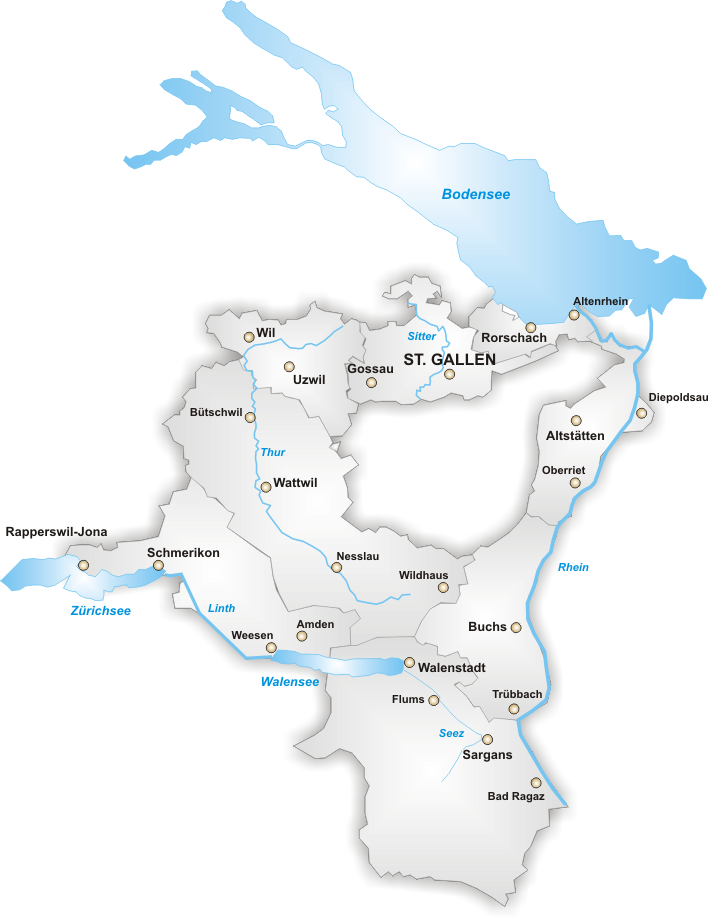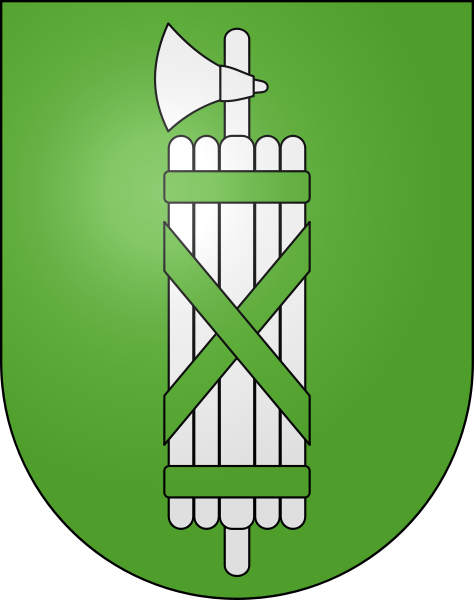Canton of St. Gallen
47.29.3Koordinaten: 47 ° N, 9 ° E; CH1903: 741029/229345 The Canton of St. Gallen (Swiss German Sanggale, French Saint -Gall, Italian San Gallo, Romansh: Son Gagl ) is a German-speaking canton in north-eastern Switzerland. The capital is the city of St. Gallen.
- 3.1 legislative
- 3.2 executive
- 3.3 judiciary
- 3.4 communities
- 3.5 Constituencies
- 3.6 Representation at the national level
- 8.1 Largest communities
- 8.2 Other known localities
Geography
The eastern Swiss canton of St. Gallen borders the Swiss cantons of Graubünden, Glarus, Schwyz, Zurich, Thurgau, in the north to Lake Constance and to the east by the Austrian state of Vorarlberg and the Principality of Liechtenstein. By the Lake Constance borders St Gallen indirectly to the German states of Baden -Württemberg and Bavaria. He also encloses the half-cantons of Appenzell Innerrhoden and Appenzell Ausserrhoden.
The highest mountain in the canton is the Ringelspitz with 3,247 m above sea level. M., however, known is probably the Santis ( 2,502 m above sea level. M. ). The deepest point is 395 meters above the sea of Lake Constance. The largest St. Gallen lakes are Lake Constance, Lake Zurich and Lake Walen, but all of which are not exclusively the St. Gallen region. The largest lake entirely on the St. Gallen region is therefore the reservoir Giger Waldsee.
Major rivers include the Rhine, the Thur, the Lindth, the sitter and the Seez.
Geographical regions are:
- Fürstenlandstrasse
- Toggenburg
- Rhine Valley
- St. Galler Oberland / Sarganserland
- Lake Constance
- Walen
- Linthebene
- Lake Zurich
In the canton of half of the total area is used as agricultural land.
Population
As of December 31, 2012 487'060 people lived in the Canton of St. Gallen.
Of the total population in 2007 27 percent were under 20 years old, 59 percent of 21 - to 65 - year, 13 percent of 66 - to 90 - year and 0.4 percent over 90 years old.
Nationality
Languages
The official language is German, spoken language is Swiss German.
Due to the heterogeneous composition of the canton by the Mediation Act 1803 exist in the canton of St. Gallen different dialects, so among other things, the Rhine Valley, the St. Gallen, Toggenburg or the Sarganserländer dialect. The Rheintaler dialect is related to the Liechtenstein and Vorarlberg dialect. In the area of Lake Zurich is a Zurich Oberland dialect, spoken rather a dialect of Glarus in Gaster. The (upper ) Toggenburg dialect similar to the Appenzell region.
Until after the Middle Ages St. Gallen Romansh is spoken in the southern regions of the canton. For this reason, many GIs are ( villages, hamlets, mountains) in the area of Romanesque origin. The local Swiss German dialects have still a Latin accent ( Sarganserland and Will Berg).
At the 2000 census, 88 percent of St. Gallen that their main language is German. In addition, 2.5 percent speak of St. Gallen Serbo-Croatian, Italian 2.3 percent and 2.2 percent Albanian. Other languages are widely under-represented.
Religions - faiths
Since the Canton of St. Gallen has been created in 1803 from different territories, it is religiously very heterogeneous. Pure catholic northern Fürstenlandstrasse are ( once owned by the St. Galler Fürstabts ), but with the exception of the traditional Reformed city of St. Gallen ( once free imperial city ), as well as the southern parts of the canton ( formerly subject territories of Central Switzerland ), among others, the Sarganserland. Occupying the western Toggenburg is mixed, but mostly reformed, is located in East Rhine Valley is also mixed, but predominantly Catholic ( except in particular the reformed former Zürich and Glarus subject territories of Sax and Will Berg).
52 percent are Roman Catholic, 26 percent are Protestant Reformed, 6 percent without denomination, 6 percent Islamic. Another ten percent belong to other denominations.
Recognized under public law, the Roman Catholic Church, the Evangelical Reformed Church, the Old Catholic Church and the Jewish community of St. Gallen.
Constitution and politics
The current cantonal constitution dated 10 June 2001 ( with changes since then ).
Legislature
Legislative organ is the cantonal parliament, which has 120 members and is elected by popular vote by proportional representation electoral law to a fixed term of four years.
About referendums, ie mandatory referendum on constitutional amendments, facultative referendum for changes in the law and people's initiatives relating to the adoption of constitutional or legislative provisions, including the voting people has a direct stake in the legislation. The vote on a law may require 4,000 voters; to propose a law, it requires the support of 6,000 voters, and to apply for a constitutional amendment are needed 8,000 voters. A general legislative activity can finally 4000 voters demand ( unit Initiative). The compulsory and optional referendum subject then government spending established by law heights.
Executive
The highest executive body is the Governing Council, which counts seven equal members of which are elected by popular vote to a fixed term of four years after the Majorzwahlrecht.
The government councils of the current legislature on June 1, 2012 to May 31, 2016 ( since the elections in the canton of St. Gallen 2012) and their respective departments are:
Head of the State Chancellery of State Canisius Braun ( since 2009).
Judiciary
Dishes at cantonal level are the Cantonal Court, the Commercial Court, the Administrative Court and the Insurance Court.
Consist of first circle and labor courts and the mediator at the regional level.
The Court of Cassation, until then cantonal supreme judicial body, was abolished on 1 January 2011.
Communities
As a decentralized units of the Canton of St. Gallen knows as normal case, the political communities.
Special municipalities are the local and school communities, but it no longer exists in the whole canton, and also the Reformed and Roman Catholic parishes.
The functions of the former districts (see below) were transferred increasingly in recent years to other bodies; institutions as the districts were finally abolished with the new cantonal constitution.
Constituencies
The Canton of St. Gallen is organized since 1 January 2003 in the following constituencies that are listed clockwise:
By the end of December 2002, the Canton of St. Gallen knew a division into districts.
Representation at national level
St. Gallen sent - as any full- Canton - two representatives in the Senate and because of its inhabitants twelve representatives to the National Council.
Economy
At the Swiss national income of St. Gallen has a share of 5.3 percent, its financial strength so that is about 80 percent of the Swiss average. The control force was estimated in 2002 at 1635 Swiss francs per inhabitant. Within the canton of the control force is different. So Mörschwil has a control force of 2798 Swiss francs, while this is in stone SG at 784 Swiss francs.
The Canton of St. Gallen offers approximately 237,000 jobs ( including part-time ), which means per 100 inhabitants on average 52 jobs.
Until about 1920, the single most important industry of the St. Gallen economy was the textile industry.
Traffic
History
The Canton of St. Gallen was created in 1803 at the request of Switzerland's deputies Karl Müller -Friedberg of Napoleon Bonaparte. The area of the canton was created from the merger of the Swiss cantons and Linth Santis minus the cantons of Glarus and Appenzell restored. This " bankruptcy estate " consisted of the following areas ( in order of size ):
- " Old countryside » St. Gallen until 1798 heartland of the Abbey of St. Gall
- Ruled county Toggenburg to 1798 of the Fürstäbten of St. Gallen
- County Sargan, until 1798 Common rule of the Confederation
- Bailiwick Windegg (gaster ) with the Office Gams, until 1798 Common rule of the Confederation
- Bailiwick Rhine Valley until 1798 Common rule of the Confederation
- County Uznach, until 1798 Common rule of the Confederation
- County Will Berg, until 1798 a peasant lands of the canton of Glarus
- Rule Sax Forstegg, until 1798 subject territory of the canton of Zurich
- Rapperswil rule until 1798 Common rule of the Confederation
- City of St. Gallen, until 1798 a free imperial city and city-republic
The canton of St. Gallen in 1803 joined the newly formed together with the other new cantons of Thurgau, Vaud, Aargau, Graubünden and Ticino as an equal member of the Federal Swiss Confederation. The short time on the st. Gallic territory formed Helvetic cantons Linth Santis and were dissolved.
The young Canton gave up in 1803 and 1814, the first cantonal constitutions and was able to hold the other in the post-Napoleonic period over territorial claims of the former Fürstabts of St. Gallen, Pancrazio Vorster, on the one hand and against separatist parts of the canton.
In the Constitution of 1814 matters were due to the religious heterogeneity of the canton as churches, marriage and school stuff not the state, but the Catholic and Protestant populations, the so-called " Canton parts » betrayed, so in addition to the general legislative Grand Council (now the Cantonal ) also a Catholic and a reformed Grand Council were introduced (→ denominational dualism ).
1831 a representative democratic constitution was introduced, which had been first directly - democratic features with the "people's veto " and the existing oligarchic regime replaced. In 1861 the state took over after violent disputes the far religious education. The strong confessionalisation coined the canton of St. Gallen but still far into the 20th century. 1875 " People's Veto " by an optional referendum ( appeal rights of the people against laws) has been replaced.
The Constitution of 1890 to facilitate the referendum and the popular election of the Governing Council were the introduction of the popular initiative ( right of the people to propose laws), modernized the rights of the people. This Basic Law was, with many changes, until the adoption of the current constitution in force until 2001 that the numerous constitutional innovations of the past century, summed up in the first place and completed the reorganization of the canton.
Coat of arms
The coat of arms of St. Gallen shows a fasces with ax (also called fasces fasces or Latin ). The origin of this bundle can be found in the Roman Empire. Lictors carried a bundle of rods with an ax ahead of senior officials. The bundle was a symbol of the judiciary. Green was considered the color of freedom. This is also visible in the coat of arms, also founded in 1803 and Vaud cantons of Thurgau. White served as the color of innocence.
The revolutionaries in France took their symbols. The Helvetic Republic took over next to the tricolor and the fasces. Compared to the French Marianne, Switzerland chose her Helvetia. After Napoleon Bonaparte founded the Canton of St. Gallen, the fasces was adopted and is today, was founded under what circumstances the canton. The St. Gallen fasces has eight (including five visible ) bars for the eight former Districts of Canton Canton at the time of inception.
In 2011 the coat of arms was changed in its form of presentation. Thus, the spike of the ax has been removed, changed the light green to a dark and designed the coat of arms form down spitzverlaufend.
Cities and towns
Largest communities
Listed below are municipalities with more than 10,000 inhabitants as of 31 December 2012:








